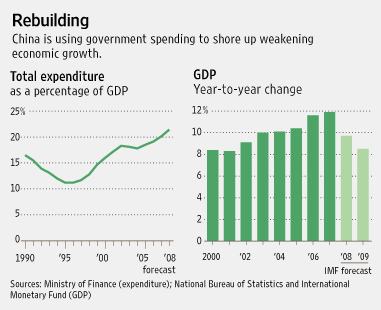Paraphrasing Nixon, have the Chinese become Keynesians now, too?
I don’t believe so.
China’s proposed $586 billion dollar stimulus plan sure generated a lot of excitement this past weekend. It was amusing to watch the SPX futures tick up on this supposed new program. Especially when we compare it with the $170 billion in tax rebates this summer — The Economic Stimulus Act of 2008 — which was only 1% of GDP of the US, versus about 18% of China’s GDP.
But is China’s plan really a new stimulus? The short answer is no, and it took the market about half a day to figure this out yesterday.
Why? Compare China — a country with a centrally planned economy, carefully managed by a communist regime — with the United States. The US has a $14 trillion economy, of which about $3 trillion is government spending (military, entitlements, discretionary). Any new stimulus plan — be it tax rebates, direct spending on public works programs, or aid to the auto industry — is essentially new spending that didn’t previously exist.
When $3 trillion becomes $3.17 trillion, it is significant. It is as if the US is adding more pieces to the economic chess board.
China, on the other hand, is merely moving resources from one region to another. They are not creating more economic activity, putting cash in the hands of consumers, or even increasing their infrastructure plans.
“Bullishness in Asia on Monday was tempered by questions about how much of China’s plan is actually new — or is simply a repackaging of past commitments, such as the rebuilding effort following the Sichuan earthquake. Investors appeared to question estimates that Beijing would spend another 6% to 7% of its gross domestic product in each year of the plan, as the raw numbers of the plan would suggest. . .
Beijing may be prepared to add extra stimulus. A Beijing think tank, the China Academy of Social Sciences, said Monday it has submitted a report to economic policy makers outlining ways for the government to offset stock-market panic. One suggestion is to deploy as much as $115 billion to buy shares in the stock market’s 50 biggest companies if the Shanghai Composite Index slips to 1500. The market remains 64% below last year’s close.
The package didn’t address one big question about China’s economic-policy plans: whether it will stoke its own domestic demand by letting the yuan rise, or act defensively to let the currency fall to relieve pressure on its own exporters.”
On their economic chess board, all they are doing is moving pieces about. But they are not actually adding anything to the board.
This Chinese economic stimulus plan is a contradiction in terms.
>

chart courtesy of WSJ
>
Further reading:
Budget of the United States Government
http://www.gpoaccess.gov/usbudget/
Budget of the United States Government
Fiscal Year 2009
http://www.whitehouse.gov/omb/budget/fy2009/
China’s Stimulus Plan Cheers Markets, But Doubts Remain
JAMES T. AREDDY
WSJ, NOVEMBER 11, 2008
http://online.wsj.com/article/SB122634126983014381.html
China’s Stimulus Plan: Repackaged and Misdirected
Derek Scissors, Ph.D.
Heritage Foundation, November 10, 2008
http://www.heritage.org/Research/AsiaandthePacific/wm2128.cfm
China Announces $586 Billion Stimulus Package
ANDREW BATSON
WSJ, NOVEMBER 10, 2008
http://online.wsj.com/article/SB122623724868611327.html


What's been said:
Discussions found on the web: